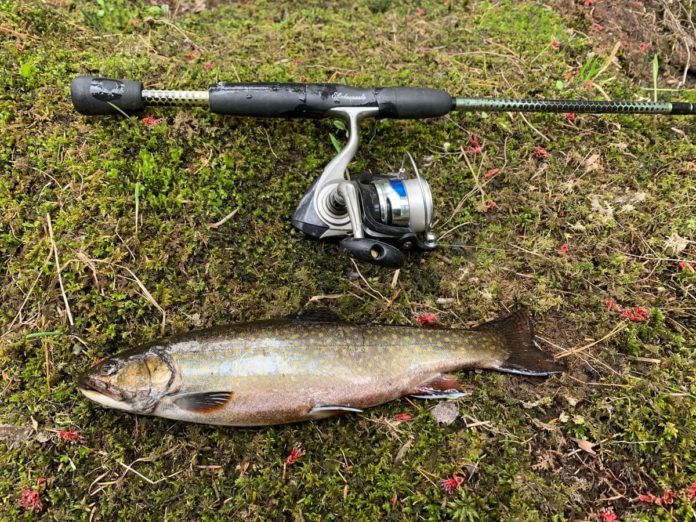As Old Man Winter slowly releases his frigid, tight grip and hands us off to the warm pleasantries of spring, it’s time to switch gears. Snowmobiles and snowshoes begin their long hibernation while pack baskets filled with ice fishing traps, creepers and handwarmers snuggle up next to ice augers in the corner of the basement. It’s been nice, winter, but now it’s time to move onto some serious business. Spring brook trout fishing!
Don’t get me wrong, the sight of a Heritage tip-up flag flying high over an ice hole on a January day will warm the soul of any angler. Arguments could be made, however, that there’s little that can match the feeling of a bent ultralight spinning rod while simultaneously fighting a swarm of blackflies and a 10-inch brook trout that mistook a fat night crawler for an easy meal.
It’s hard to pinpoint exactly why spring fishing, especially for brook trout, is so special. Maybe it’s the warm weather, the birds chirping, that distinct earthly smell of a fast-running stream or the lifelong quest for the holiest of holy grail secret spots. For some, it’s the promise of a hot cast iron pan playing host to crisping, curling fish no bigger than bait for other excursions.
A safe wager could be made, I bet, that for most of us in Maine, our first most notable fishing expedition took place on the bank of a small stream or brook. The gear: simple. The target: cunning and wary. The challenge: intoxicating. And the memory: unforgettable.
Perhaps the beauty and allure of brook trout fishing can be found in its simplicity. We live in a world filled with advancement and improvement. Fishing has followed suit and it’s easy to get caught up in the high-tech trophy outdoor culture, which measures success only in pounds and inches. A world where you need a certain exact rod and tackle matched specifically to every possible situation. A world that necessitates the “perfect presentation” at the perfect time to secure a postcard picture of an average fish held well beyond normal arm’s reach in order to solidify that “trophy” of a lifetime image.
Let’s face it, most of our targeted fish are in the 6- to 12-inch range. Perfect for the pan or to satisfy that youthful calling, they certainly aren’t reliant on a $200 rod and $300 pair of waders to pluck them from their watery dwellings.
Gear is simple and refreshing. For most situations, a simple lightweight spinning rod in the 4- to 5 1/2-foot range, matched with cheap 4- to 6-pound monofilament line will do just fine. Terminal gear is even more simple. A size six or eight baitholder hook with a small split shot sinker clinched a foot above will be perfect. A half a dozen more of each in a small container stashed in a pocket will be more than enough for an outing. Bait? Well, most any gas station or convenience store can supply you with a dozen trout worms or better yet, crawlers, which are my preference. I like to thread a nice, juicy crawler onto the hook while others prefer to ball worms tightly. Nostalgically and rightfully so, it really comes down to what your grandfather taught you.
Curious about that “perfect presentation”? Everyone has their own trout fishing methodology but mine is simple and consists of two pretty straightforward approaches. In areas where fast running waters dump into larger pools, cast high into the current, leaving the bail open to allow free spooling of line until it slacks slightly near the end of the pool then slowly retrieve, reeling twice and lifting the rod tip slightly to bounce the crawler off the bottom. Repeat until hookup. In other areas identified as likely trout hideouts such as undercut banks, foam pockets or eddies, simply dunk the crawler (or worm if the waterway is small) and wait for the strike.
I suspect the diehard fly fishermen reading this will scoff at that idea of “worm dunking” and would prefer to dissect a more gentlemanly approach to the matter. Do not fret, my brethren, for I too have spent countless hours retrieving wayward flies from many a tree in tight quarters.
Though I maintain a strong allegiance to the “hook and worm” method these days, over the years I have found tremendous success filling my creel with a cheap South Bend 4/5 weight 6 1/2-foot flyrod, tossing a Walmart size twelve Hornberg into riffles and pockets. It’s quite easy. In fact, that rod I received as a young boy of 10 was strapped to a Huffy bicycle for several years and it probably accounts for most of my five-fish limits as a youth. I still have that rod and ceremoniously use it each year in order to consider myself a “purist”.
The sun is shining, the snow is melting and the waters are warming. We know it and the trout do too. I’m sure many have week-long trips planned soon to far-away places in hopes of catching the monster fish of their dreams. I may have one of those trips in mind. Regardless, I encourage all, no matter skill or experience level, to take at least one afternoon this spring “when the leaves are as big as a mouse’s ear,” to walk an unbeaten path into a favorite secret spot and feel like a kid again. Tight lines and bent rods, my friends.
More articles from the BDN
Credit: Source link































